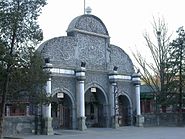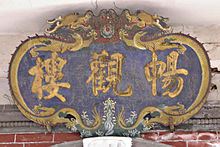Beijing Zoo
| Beijing Zoo | |
|---|---|
 Front gate | |
 | |
| 39°56′19″N 116°20′00″E / 39.93861°N 116.33333°E | |
| Location | Beijing, China |
| Land area | 89 ha (220 acres) |
| No. of animals | 14,500 |
| No. of species | 950 |
| Website | www |
The Beijing Zoo (simplified Chinese: 北京动物园; traditional Chinese: 北京動物園; pinyin: běi jīng dòng wù yuán) is a zoological park in Beijing, China, in Xicheng District. Founded in 1906 during the late Qing dynasty, it is one of the oldest zoos in China. The zoo is also a center of zoological research that studies and breeds rare animals from various continents
The zoo occupies an area of 89 hectares (220 acres), including 5.6 hectares (14 acres) hectares of lakes and ponds. It has one of the largest animal collections in the country. The zoo and its aquarium have over 450 species of land animals and over 500 species of marine animals; in all, it is home to 14,500 animals.[when?][1]
More than six million people visit the zoo each year. Like many of Beijing's parks, the zoo's grounds resemble classical Chinese gardens, with flower beds amidst natural scenery, including dense groves of trees, stretches of meadows, small streams and rivers, lotus pools, and hills dotted with pavilions and historical buildings.[citation needed]
The Beijing Zoo is well known for its collection of rare animals endemic to China including the giant pandas, which are zoo's most popular animals, the golden snub-nosed monkey, South China tiger, white-lipped deer, Pere David's deer, crested ibis, Chinese alligator, and Chinese giant salamander. Other endangered or threatened species housed there include a Siberian tiger, yak, Przewalski's horse, snow leopard, Tibetan gazelle, and kiang. The zoo also has a broad collection of megafauna such as addax, Asian black bears, Asian and African elephants, bats, beluga whales, chimpanzees, clouded leopards, flamingos, gorillas, hippopotamuses, jaguars, kangaroos, lemurs, lions, muntjac, otters, penguins, polar bears, rhinoceroses, sea turtles, tapirs, and zebras, as well as 13 of the world's 15 species of cranes.[citation needed]
History





The zoo grounds originally housed an imperial manor during the Ming dynasty, that became part of the estate of the general Fuk'anggan during the Qing dynasty. In 1906, the Imperial Ministry for Agricultural, Industry and Commerce established an experimental farm, which held a small menagerie. The Viceroy of Liangjiang, Duanfang, purchased a batch animals from Germany and deposited them there. The animal collection attracted great interest when the farm opened to visitors in 1908. Empress Dowager Cixi and the Guangxu Emperor each visited the zoo twice. The farm was known as the Wanshouyuan or the "Garden of Ten Thousand Beasts".
Among the historical buildings at the zoo is Changguanlou, a Baroque-style country-palace of Empress Dowager Cixi, designed by a French architect and built in 1908. It remains one of the best preserved Western-style palaces in China.[2]
After the Qing dynasty was overthrown in 1911, the zoo became a national botanical garden during the Republican period. During the Second Sino-Japanese War, many of the zoo's animals died of starvation, and some were poisoned by the Imperial Japanese Army.[citation needed] Only 13 monkeys and one old emu survived the war. In the 1930s, with French aid, Lamarck Hall, named after the botanist Jean-Baptiste Lamarck, was built at the experimental farm and housed plant research.
After Beijing became the capital of the People's Republic of China in 1949, the city government renamed the Beijing Agricultural Experimentation Center the Western Suburban Park (西郊公园) and began gradually rebuilding the zoo. In 1952, national leaders Mao Zedong, Zhu De, and Ren Bishi donated their war horses to the park.
The park was renamed the Beijing Zoo in 1955. The zoo sent staff to study zoo management in the Soviet Union and Poland, and began to trade animals with Eastern Bloc countries - Burma, India, Indonesia, and Japan - to expand its collection. Leading Chinese universities also established a research presence in the zoo to study animal behavior and to breed endangered species.
The zoo's development came to an abrupt halt during the Cultural Revolution as zoo staff were purged, research work stopped, and contacts with foreign zoos were severed. In the 1970s, as China forged diplomatic relations with the Western bloc, the zoo received animal gifts from the Australia, France, Mexico, Nepal, Spain, Sri Lanka, the United Kingdom, and the United States. The zoo also organized a four-year mission to Ethiopia, Kenya, and Tanzania, which brought back 157 species and 1,000 animals including and aardvark, African elephant, baboon, giant tortoises, giraffe, Grant's gazelle, oryx, ostrich, Thomson's gazelle, wildebeest, and zebra.
During the 1984 Summer Olympics, the Beijing Zoo sent a pair of giant pandas, Yingxin and Yong Yong, to Los Angeles for an exhibition. In 1987, Yong Yong and Ling Ling went on exhibition at the Bronx Zoo.
Present
The zoo has developed rapidly since 1955. antelopes, bears, elephants, giraffes, hippos, lions, pandas, rhinoceroses, songbirds, and tigers were brought in the late 1950s, and monkey and gorilla cages, and an aquarium house were opened. The reptile house contains specimens of over 100 species from all over the world, including crocodiles and pythons.
The buildings in the zoo cover an area of more than 50,000 square meters, including the elephant hall, the lion and tiger hall, the monkey hall, the panda hall, and many others. Altogether, there are more than 30 large halls.
Visitors to the zoo can also explore its many Qing dynasty buildings.
- Venues
-
Panda House
-
The Zoology Museum
-
The Beijing Aquarium
-
The Aquarium interior
Beijing Aquarium
The Beijing Aquarium, which is considered part of the zoo, was opened to the public in 1999. It is the biggest aquarium in China. In addition to a wide range of fish species, visitors can watch shows performed by dolphins, belugas, and sea lions.
Location and access
The Beijing Zoo is located at 137 Xizhimen Wai Dajie in Xicheng District, just west of the northwest corner of the 2nd Ring Road. Outside the zoo is a local public transit hub with Beijing Zoo Station on Line 4 of the Beijing Subway and terminals for Beijing Bus routes 7, 15, 19, 102, and 103. Bus routes 27, 105, 107, 111, 206, 209, 347, 601, 632, and 732 also stop at the zoo.
Nearby attractions
The Beijing Planetarium is located diagonally across the street from the zoo's main entrance. To the west of the zoo is the Purple Bamboo Park. To the east is the Beijing Exhibition Center and the Moscow Restaurant.
Controversies
According to a 2010 article in The Guardian, a restaurant located in the Beijing Zoo, named Bin Feng Tan," offers various dishes of exotic animals on its menu.[3] The restaurant manager commented that its dishes were within the law, as the animal products were supplied by exotic animal farms.[3] However, the restaurant has received a backlash since the news spread. Ge Rui of the International Wildlife Fund describes the restaurant's menu and practices as "utterly inappropriate for a zoo" and "socially irresponsible."[3] Following the negative coverage, the restaurant stated they would be revising the menu.[3]
In popular culture
A significant portion of James Rollins' Sigma Force novel, The Bone Labyrinth (2015), takes place in, near, and below the Beijing Zoo. Rollins depicts unsanitary and inhumane conditions at the zoo, and inhumane animal experimentation there. In the "Author's Note to Readers: Truth or Fiction", Rollins writes: "I did visit the Beijing Zoo and found the state of that zoological park to be appalling. The government continues to hint at changes and plans to move the place into a larger facility outside the city with more modern accommodations. So hopefully now that I've blown it up, they'll get on with those plans."[4]
See also
References
- ^ "Beijing zoo". The China Magazine.
- ^ (Chinese) [1] Accessed 2012-04-06
- ^ a b c d Jonathan Watts (2010-05-21). "Hippopotamus on menu at Beijing zoo | Environment | guardian.co.uk". London: Guardian. Retrieved 2012-06-09.
- ^ Rollins, James (2015). "Author's Note to Readers: Truth or Fiction". The Bone Labyrinth.








